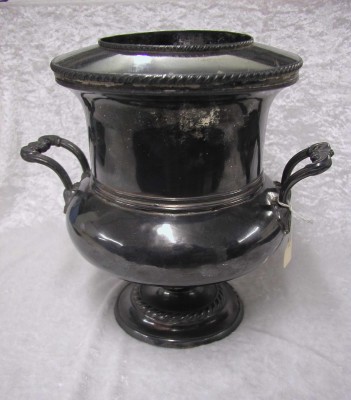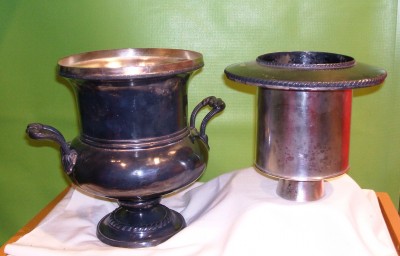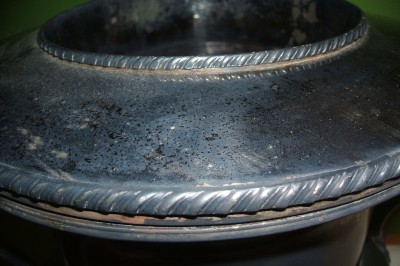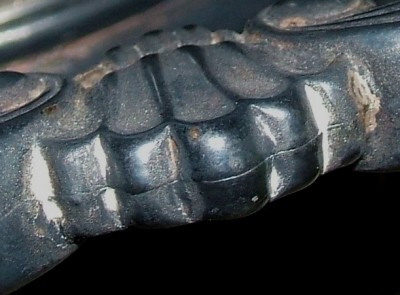Exhibit spotlight: The Cohen family’s wine cooler, early 19th century
A blog post by Collections Manager Joanna Church. To read more posts from Joanna click HERE.
The artifacts on display in “The A-Mazing Mendes Cohen” exhibit are few, but fabulous. Take, for example, this early 19th century silver-plated wine cooler, from the Cohen house on North Charles Street, Baltimore.
Donated to the JMM in 1978 by Florence H. Trupp, this 11 inch cooler is in excellent – if tarnished (more on that in a moment) – condition. It is unmarked, but was likely made in Sheffield, England, where many factories turned out a wide variety of silver-plated tableware and decorative items in what came to be known as Sheffield Plate.
Wine coolers were popular in the 18th and 19th centuries. Both functional and decorative, they were available in a variety of styles and materials, including silver, silver-plate, glass, ceramic, and wood; take a look at some examples in the collections of the Met, here. Our particular artifact was originally one of a pair, intended for use on the table in the dining room (or other party venue), each holding a single bottle. Crushed ice would be packed into the base and covered by the canister-shaped liner or insert, leaving the bottle sitting cool and dry inside the liner.
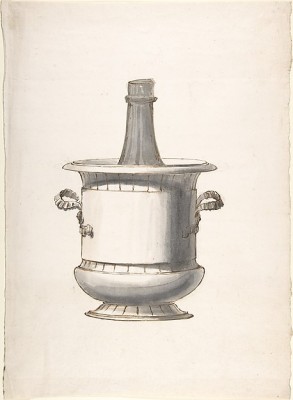
“Wine Cooler with Bottle,” Anonymous, Italian, 19th century. From the Elisha Whittelsey Collection, The Elisha Whittelsey Fund, 1953, Metropolitan Museum of Art. www.metmuseum.org
The donor informed us of the artifact’s history at the time of donation. The Cohens were one of the first Jewish families of Baltimore, and they were members of the city’s social elite. A wonderful description of a fancy dress ball, given by Benjamin I. and Kitty Etting Cohen in 1837, can be found in a letter written by Rebecca Lloyd Post Shippen to her mother; Mrs. Shippen focused mostly on the important guests in attendance, but she also described the house itself:
“You remember that everything about the house is rich and expensive . . . . The principle Table extended the length of the Room, decorated with beautiful China, cut glass and Silver . . . . [Everything was] served in the best style.” (Published in the Maryland Historical Magazine, Volume XIV, 1919.)
“The best style” certainly applies to this artifact. The campana (bell or urn) shape was a popular form; other fashionable elements include the shell handles, and the gadrooning around the collar and base. When polished and gleaming, holding the best selection from your wine cellar, it would have been an impressive part of a well-set table.
That certainly lends credence to the idea that this particular piece belonged to a well-to-do family like the Cohens. Even better is the fact that our cooler matches, almost exactly, the description found in the catalog of the 1929 auction of the Cohen household’s effects:

“224. Pair Sheffield Wine Coolers. Urn shape on baluster foot. Handles with shell gadroon. All parts complete. Gadroon motif about foot and edge of mouth. Part of Judith Cohen wedding presents. 18th century. Height 11 inches. Width 11 inches.” From the catalog for the sale of “The Antique Furnishings of the Cohen House,” 1929. JMM# 1984.20.2, donated by Arthur J. Gutman.
(It is worth noting that the cataloger, Robert Frank Skutch, assigned too early a date; this style is more typical of the 1810s-30s than the 18th century. Sadly, that rather negates the wedding gift story, since Judith Solomon married Israel I. Cohen in 1787.)
The multi-day auction was covered by the Baltimore Sun in a series of articles; unfortunately, not every item caught the reporter’s attention, so I’ve not yet discovered the purchaser of the Sheffield wine coolers, nor their final price. (I did learn, however, that a delegate sent by Henry Ford – yes, that Henry Ford – got into a bidding war with Manny Hendler over a pair of lamps. Mr. Ford won.) The newspaper reports indicate that the auction was a big deal both locally and in the broader antique-collecting community, in part because of the age and quality of the items up for sale, but also because of the Cohen family’s prominence in the city. As Skutch noted in his Introduction to the auction catalog:
“The Cohen family from the beginning of the last century maintained open house. Here, mingled the culture, public spirit, and social grace of early Baltimore. Fine living was an inborn characteristic of this family, and they maintained a home worthy of the best traditions of Baltimore, and of Maryland.”
…As for the wine cooler’s current lack of shine, there is a good reason for it. Silver is, in its way, quite fragile; the polishing and buffing you give your household pieces can be extremely damaging over time, and museums are particularly careful with their silver goods. Removing tarnish actually removes a layer of silver, which is definitely to be avoided with silver-plated items; the mechanical process of handling and cleaning an artifact is an opportunity for accidental damage; and any polish residue – or even water – left in the nooks and crannies of decoration is both unattractive and harmful.
In an ideal situation, silver and silver-plated items are initially (and gently) polished, then stored and/or displayed in appropriately tarnish-inhibiting environments, thus minimizing the need for future cleaning. In this case, however, the wine cooler was already in a tarnished state, and our exhibit design did not allow for an elaborate case; tarnish would have built up again over the months the artifact was on display. Rather than create a need for multiple polishing sessions, we concluded it was safer to leave it be for now. Though the visual impact is somewhat diminished, the wine cooler’s elegant form, expensive material, and general “extra”ness (what, you think I’d just put the bottle on the table? Oh no! I’ve got a fancy silver container!) nonetheless help us illustrate the Cohen family’s important position in Baltimore society.
Come see the Cohen family’s artifacts – and read the entirety of Mrs. Shippen’s letter – in person! “The A-Mazing Mendes Cohen” is on display at the Jewish Museum of Maryland through June 14, 2015.

